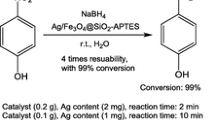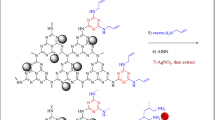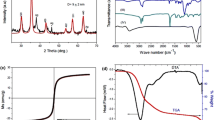Abstract
In this study, the anti-oxidative potential of Simaba trichilioides was exploited to produce uniform Ag nanoparticles followed by their in-situ immobilization on a multifunctional magnetite–mesoporous ZnO composite (Fe3O4@mZnO). The strategy is to combine the advantages of solid supported catalysts and the green, available and non-toxic polyphenolic metabolites, acting as both the reducing and stabilizing agents, for the green synthesis of silver nanoparticles. The new bioinspired catalyst (Fe3O4@mZnO-AE-1-Ag) was applied in the photodegradation of Rhodamine-B solutions and outstanding catalytic activity was achieved. Under the studied conditions, the catalyst could be easily magnetically isolated, and a single sample of the material could be used for at least 13 times (degradation higher than 80%) and 16 times (degradation higher than 70%). The material was characterized by transmission electron microscopy (TEM and HRTEM), XPS (X-ray photoelectron spectroscopy), EDX (Energy-dispersive X-ray spectroscopy), HPLC-DAD, and LC-MS.

Highlights
-
Well-dispersed Ag nanoparticles were synthesized using an in-expensive, efficient and bio-inspired approach.
-
The Ag NPs were immobilized on a multifunctional magnetic support (Fe3O4@mZnO).
-
Rhodamine-B aqueous solution was efficiently photodegraded using the new catalyst.
-
High catalytic stability and magnetic behavior allowed a quick catalyst separation and outstanding recycling.
-
Ag nanoparticle size is governed by both the multifunctional material (Fe3O4@mZnO) and the constituents of Simaba trichilioides.










Similar content being viewed by others
References
Rajan R, Chandran K, Harper SL, IIYon S, Kalaichelvan PT (2015) Plant extract synthesized silver nanoparticles: An ongoing source of novel biocompatible materials. Ind Crop Prod 70:356–373
Jain S, Mahata MS (2017) Medicinal plant leaf extract and pure flavonoid mediated green synthesis of silver nanoparticles and their enhanced antibacterial property. Sci Rep 7:15867
Ojha S, Sett A, Bora U (2017) Green synthesis of silver nanoparticles by Ricinus communis var. carmencita leaf extract and its antibacterial study. Adv Nat Sci 8:1–8
Roy P, Das B, Mohanty A, Mohapatra S (2017) Green synthesis of silver nanoparticles using Azadirachta indica leaf extract and its antimicrobial study. Appl Nanosci 7:843–850
Chung M, Park I, Seung-Hyun K, Thiruvengadam Muthu, Rajakumar G (2016) Plant-mediated synthesis of silver nanoparticles: their characteristic properties and therapeutic applications. Nanoscale Res Lett. 11(1):40
Ahmed S, Ahmad M, Swami BL, Ikram S (2016) A review on plants extract mediated synthesis of silver nanoparticles for antimicrobial applications: a green expertise. J Adv Res 7:17–28
Peng F, Wang Q, Shi R, Wang Z, You Z, Liu Y, Wang F, Gao J, Mao C (2016) Fabrication of sesame sticks-like silver nanoparticles/polystyrene hybridnanotubes and their catalytic effects. Sci Rep 6:39502
Xia X, Zeng J, Zhang Q, Moran CH, Xia Y (2012) Recent developments in shape-controlled synthesis of silver nanocrystals. J Phys Chem C Nanomater Interfaces 116:21647–21656
Barbosa LF, Braz-Filho R, Vieira IC (2011) Chemical constituintes of plants from genus Simaba (Simaroubaceae). Chem Biodiv 8:2163–2178
Alves IABS, Miranda HM, Soares LAL, Randau KP (2014) Simarobaceae family: botany, chemical composition and biological activities. Braz J Pharmacogn 4:481–510
da Silva RA, Jacinto MJ, Silva VC, Cabana DC (2018) Urea-assisted fabrication of Fe3O4@ZnO@Au composites for the catalytic photodegradation of Rhodamine-B. J Sol-Gel Sci Technol 86:94–103
Park J, An K, Hwang Y, Park J, Noh H, Kim J-Y, Park J-H, Hwang N-M, Hyeon T (2004) Ultra-large-scale syntheses of monodisperse nanocrystals. Nat Mater 3:891–895
Li F, Dong B (2019) Facile two-step synthesis of Ag nanoparticles dispersed on N, S co-doped RGO for highly efficient plasmonic photocatalytic water purification. Catal Commun 119:42–45
Prieto P, Nistor V, Nouneh K, Oyama M, Abd-Lefdil M, Díaz R (2012) XPS study of silver, nickel and bimetallic silver-nickel nanoparticles prepared by seed-mediated growth. Appl Surf Sci 258:8807–8813
Zhang X, Liu D, Li L, You T (2015) Direct electrochemistry of glucose oxidase on novel free-standing nitrogen-droped carbon nanospheres @carbon Nanofibers composite film. Sci Rep 5:9885
Rieger KA, Porter M, Schiffman JD (2016) Polyelectrolyte-funcionalized nanofibers mats the collection and Inactivation of Escherichia coli. Materials (Basel) 9(4):E297
Zhang Z, Wu Y, Wang Z, Zou Z, Zhao Y, Sun L (2016) Fabrication of Silver nanoparticles embedded into polyvinyl alcohol (Ag/PVA) composite nanofibrous films through electrospinning for antibacterial and surface-enhanced Raman scattering (SERS) activities. Mater Sci Eng C 69:462–469
Dad M, Lancee RJ, van Vuuren MJ, van de Loosdrecht J, Hans Niemantsverdriet JW, Fredriksson HOA (2017) SiO2-supported Fe & FeMn Colloids–Fischer-Tropsch synthesis on 3D model catalyst. Appl Catal A 537:83–92
Yung X, Duan S, Wu G, Sun L, Cao G, Li D, Xu H, Li Q, Xia D (2018) Enhanced catalytic ozonation performance of highly stabilized mesoporous ZnO doped g-C3N4 composite for efficient water decontamination. Appl Catal A 551:129–138
Feng P, Ying G, Feng-Feng C, Tao F, Shu-De Y (2011) Synthesis of ZnFe2O4 nanomagnets by Fe-ion implantation into ZnO and post-annealing. Chin Phys B 20:127501–127506
Kloprogge JT, Duong LV, Wood BJ, Frost RL (2006) XPS study of the major minerals in bauxite: Gibbsite, bayerite and (pseudo-)boehmite. J Colloid Interface Sci 296:572–576
He Z, Yang S, Ju Y, Sun C (2009) Microwave photocatalytic degradation of Rhodamine B using TiO2 supported on activated carbon: mechanism implication. J Environ Sci 21:268–272
Yu K, Yang S, He H, Sun C, Gu C, Ju Y (2009) Visible light-driven photocatalytic degradation of rhodamine B over NaBiO3: pathways and mechanism. J Phys Chem 113:10024–10032
Chen F, Zhao J, Hidaka H (2003) Highly selective deethylation of rhodamine B: adsorption and photooxidation pathway of the dye on the TiO4/SiO2 composite photocatalyst. Int J Photoenergy 5:209–217
Natarajan K, Singh P, Bajaj HC, Tayade RJ (2016) Facile synthesis of TiO2/ ZnFe2O4 nanocomposite by sol-gel auto combustion method for superior visible light photocatalytic efficiency. Korean J Chem Eng 33:1788–1798
Acknowledgements
The authors are grateful to Fundação de Amparo a Pesquisa do Estado de Mato Grosso (FAPEMAT) and Conselho Nacional de Desenvolvimento Científico e Tecnológico (CNPq) for financial support, and indebted to LNNano-Brazil and LCE-DEMA-UFSCAR for XPS and TEM analyses, respectively.
Author information
Authors and Affiliations
Corresponding author
Ethics declarations
Conflict of interest
The authors declare that they have no conflict of interest.
Additional information
Publisher’s note: Springer Nature remains neutral with regard to jurisdictional claims in published maps and institutional affiliations.
Rights and permissions
About this article
Cite this article
Jacinto, M.J., Vasconcelos, L.G., Sousa, P.T. et al. Biosynthesis of Ag nanoparticles and their immobilization on multifunctional ZnO materials–a step closer to environmental feasibility. J Sol-Gel Sci Technol 91, 21–32 (2019). https://doi.org/10.1007/s10971-019-05014-2
Received:
Accepted:
Published:
Issue Date:
DOI: https://doi.org/10.1007/s10971-019-05014-2




